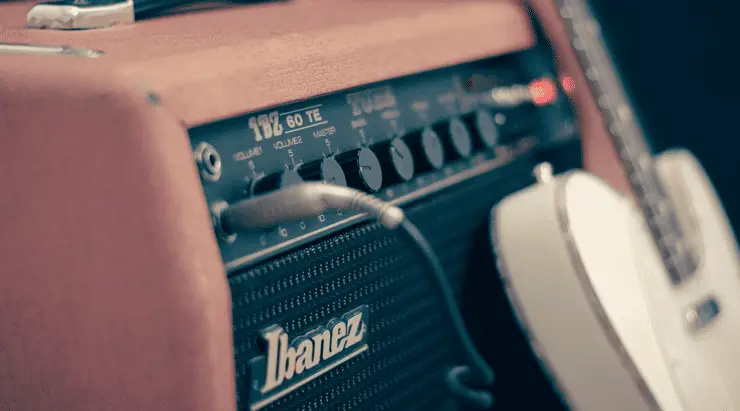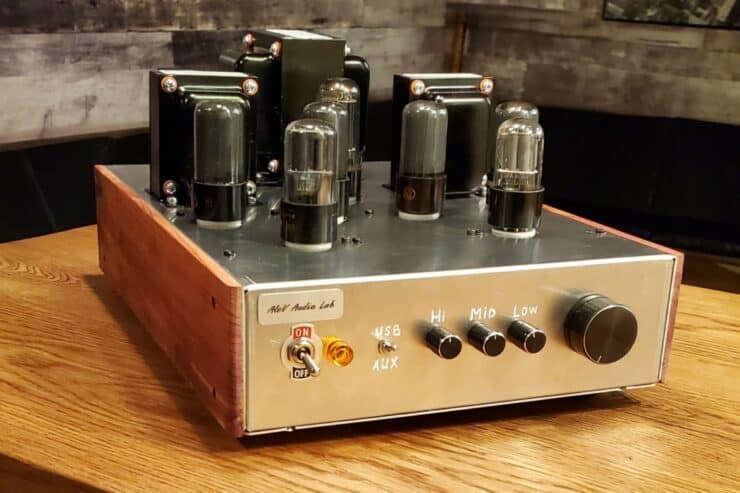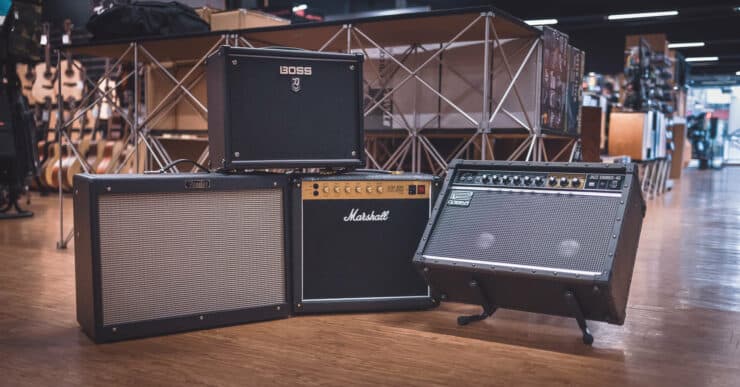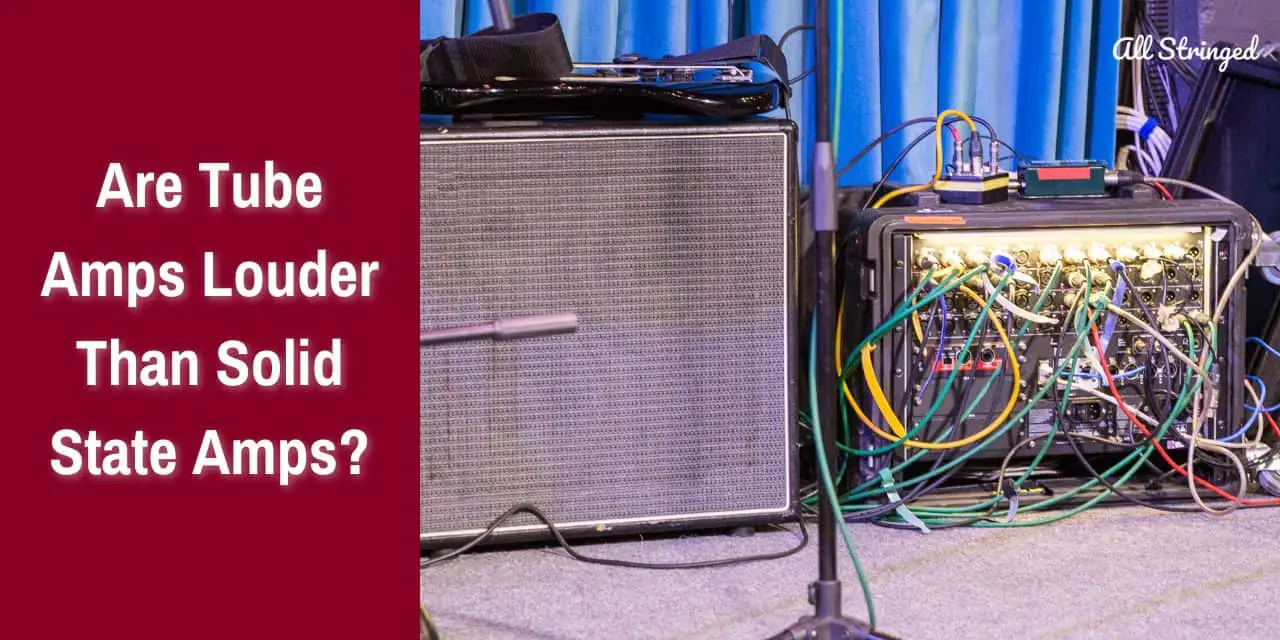Are tube amps louder than solid state amps? For guitar players of all levels, this is a question that comes up often. As you may know, tube amps and solid state amps are two of the most popular types of guitar amps, but how do they compare when it comes to sound? In this article, we will dive deep into the differences between the two and answer the question of which type of amp is the loudest. So, if you’re looking for an answer to this popular question, read on to find out all the details!
Definition of tube amps and solid-state amps
Guitar amps are a key component for any musician or guitarist, especially electronic guitar players. They provide the amplification needed for projecting the guitar’s sound to an audience and shaping the tonal characteristics of the instrument.
When it comes to guitar amps, two types of guitar amps reign supreme – tube amps and solid-state amps. Both of these amps come with their unique qualities, which have been the subject of various debates in the music world.

Tube amplifiers
Tube amps or also known as valve amps use vacuum tubes for amplifying the signal from the guitar. This technology has been around since the early 1900s and was used extensively in early radio in TV sets. In the guitar world, tube amps are widely revered for their warm and natural tone. The tubes in tube amps create a natural distortion that is often referred to as “tube saturation”, which gives the guitar a rich and full sound.
>>> Click here to read our review about the Top 15 Best Tube Amps <<<
Tube amps are widely known for their sensitivity to touch and playing dynamics. The amount of distortion and tone produced in tube amps can vary greatly depending on how hard the guitarist plays. This sensitivity is a particular reason why tube amps are often preferred by musicians and guitarists who play blues, jazz, and classic rock.
Tube amps are also known for their high maintenance requirements. The tubes in a tube amp have to be replaced from time to time. Moreover, the amp itself will have to be serviced regularly. Tube amps are typically more fragile and delicate compared to solid-state amps, so they will have to be handled with care.
Solid-state amplifiers
Solid-state amps, on the other hand, make use of semiconductor devices like transistors and diodes for amplifying the signal from the guitar. Solid-state technology has been around since the 1950s, and it has become increasingly popular thanks to it being extremely reliable, versatile, and affordable.
Solid-state amps are known for their clean and crisp tone. These amps do not have the natural distortion that tube amps produce. However, they can still produce distortion through the use of overdrive and distortion pedals. Solid-state amps are also known for their high headroom, which means that they can handle a lot of volume without distorting.
Solid-state amps are comparatively easier to maintain than tube amps. They do not have tubes that have to be replaced, and they’re generally more durable and rugged. Solid-state amps are generally more affordable than tube amps, which makes them such a popular choice for beginners and hobbyists.
Differences between tube amps and solid-state amps
When it comes to guitar amps, tube amps and solid-state amps dominate the market. Both of these types of guitar amps come with unique qualities and have been the subject of a lot of debate among guitar players. There are numerous differences between tube amps and solid-state amps. Once you are aware of these differences, you’ll be able to make better, well-informed decisions. So without further ado, let’s find out the primary differences between tube amps and solid-state amps.
#1. Technology
The primary difference between tube amps and solid-state amps is the technology used by these amps for amplifying the signal from the guitar. Tube amps make use of vacuum tubes, whereas solid-state amps use semiconductor devices like diodes and transistors.
#2. Tone
One of the key differences between tube amps and solid-state amps is the way the two types of amps produce tones. Tube amps are known for their warm, rich, and natural sound. These amps are capable of creating natural distortion, which is often referred to as “tube saturation”. This distortion gives the guitar a full-bodied sound that is commonly preferred by guitarists who play jazz, blues, and classic rock.
Solid-state amps, on the other hand, offer a clean and crisp tone. They don’t produce natural distortion like tube amps, but they’ll still produce distortion through the use of overdrive and distortion pedals. Solid-state amps are typically preferred by guitarists who play heavy genres like metal and punk, while a clean and sharp tone will be required.
#3. Sensitivity
Another major difference between tube amps and solid-state amps is their sensitivity to playing dynamics. Tube amps are highly sensitive to touch and playing dynamics. The amount of distortion and tone produced by tube amps can vary greatly depending on how hard the guitarist plays. This sensitivity is a major reason why tube amps are often preferred by guitarists who play jazz, blues, and classic rock.
Solid-state amps are less sensitive to playing dynamics compared to tube amps. They offer a higher headroom, which means that they’re able to handle a lot of volume without distorting. This makes them the preferred option by guitarists who play heavy genres like punk and metal, where a high level of volume is needed.
#4. Maintenance
Tube amps need more maintenance compared to solid-state amps. The tubes in a tube amp have to be replaced periodically, whereas the amp itself will have to be serviced regularly. Tube amps are also more fragile and delicate compared to solids-state amps, so they’ll have to be handled with care.
Solid-state amps happen to be more reliable and need less maintenance than tube amps. They do not have tubes that have to be replaced, and they’re generally more durable and rugged. This makes them an incredibly popular choice for beginners and casual players who don’t want to deal with the maintenance and upkeep of a tube amp.
#5. Cost
Tube amps are typically more expensive than solid-state amps. This is the case because they make use of more expensive technology and need more maintenance. Solid-state amps happen to be more affordable than tube amps, which is why they’re the popular choice for beginners and novices.

Are tube amps louder than solid-state amps?
When it comes to guitar amps, there are numerous factors that can affect the loudness of the amp. Speaker sizes, power ratings, tone controls, and more are some of the factors that can impact how loud the amps can get. But which amp is capable of being louder, and are tube amps louder than solid-state amps?
The answer is no, tube amps are not louder than solid-state amps, and vice versa. However, there are various reasons why you may think that they are. The issue ultimately comes down to headroom and the way the two types of amps manage the available power.
A tube amp gradually clips, which pushes it into overdrive as you crank up the volume. For high-powered tube amps, like 100W heads, you’ll be able to crank them quite a bit before they start breaking up, and they keep on going into the sweet overdrive range. This means that you will be able to turn the tube amp up really loud and get amazing sounds out of it.
Solid-state amps, on the other hand, behave very differently as you crank up the volume. Unlike tube amps that gradually drift into overdrive before needing more, when solid-state amps approach their maximum usable power, things could start to get ugly. You will only be able to turn a solid-state amp up to a certain point and still get a clear, usable sound without getting over-distorted.
Here are the factors that define how loud tube amps and solid-state amps are –
#1. Power ratings
One of the most important factors that affect the loudness of an amp is its power rating. The power rating of an amp is measured in watts and represents the amount of power the amp can output. Generally, the higher the wattage, the louder the amp will be.
Tube amps and solid-state amps come with different power ratings. Tube amps typically come with lower wattage, while solid-state amps have a higher wattage. This happens because tube amps need more power for achieving the same level as a solid-state amp.
#2. Speaker sizes
Another factor that can greatly impact the loudness of an amp is the size of the speaker. The larger the speaker, the louder will be the amp. This is because larger speakers can move more air and produce more sound.
Tube amps and solid-state amps can have different speaker sizes, with tube amps largely having smaller speakers whereas solid-state amps have larger speakers. This is because tube amps are often used for music genres like jazz and blues, whereas a smaller speaker can produce a more natural and warm tone. Meanwhile, solid-state amps are often used for genres like metal and punk, where a larger speaker is capable of producing a sharper and more aggressive tone.
#3. Tone controls
Lastly, the tone controls on an amp can also affect the loudness of the amp. Tone controls, such as bass, treble, and mid can be used for adjusting the overall tone of the amp. Increasing the bass or treble can make the amp sound louder, even if the volume level remains the same.
Tube amps and solid-state amps can have different tone controls, with tube amps typically having simpler tone controls and solid-state amps having more complex tone controls. This is because tube amps are often used for music genres where a natural and warm tone is preferred. Meanwhile, solid-state amps are often used for music genres where a more aggressive and detailed tone is needed.
Pros and cons of tube amps
Tube amps have been around for decades, and they are still a popular option among musicians and guitarists today. Tube amps have a unique sound that many people find appealing alongside many other pros. However, they are not perfect either, as they do come with some drawbacks that need to be considered. Here are some of the pros and cons of tube amps.
The pros of using tube amps are –
#1. A warm, rich tone
One of the biggest pros of using tube amps is their tone. Many guitarists love the warm, rich, and natural sound of a tube amp. Tube amps are capable of producing a sound that is often described as “creamy”. This tone is achieved due to the way the tubes amplify the guitar signal.
#2. Dynamic range
Another benefit of tube amps is their dynamic range. Tube amps can produce a wide range of sounds, from clean to overdriven to distorted. The tubes in a tube amp are capable of handling a lot of power, which allows them to produce a more dynamic sound.
#3. Harmonics
Tube amps are capable of producing a lot of harmonics, which can add depth and complexity to the guitar’s sound. These harmonics are often described as “organic” and “musical”.
#4. Reliability
While tube amps need more maintenance, they are typically very reliable. Tubes can last for many years if they take care of them properly.
The cons of using tube amps are –
#1. A high cost
One of the biggest drawbacks of tube amps is their cost. Tube amps are generally more expensive compared to solid-state amps. Moreover, replacing tubes can also be quite costly.
#2. Fragility
Another drawback of tube amps is their fragility. Tubes can break or malfunction if they are not handled carefully. Moreover, tube amps can also be sensitive to changes in temperature or humidity.
#3. Maintenance
Tube amps require more maintenance. The tubes in the amp have to be replaced periodically, whereas the biasing will also have to be adjusted. The entire maintenance process can be costly and time-consuming.
#4. Weight
Tube amps are often heavier than solid-state amps. This can make them quite difficult to transport and set up.
Pros and cons of solid-state amps
Just like tube amps, solid-state amps are also quite popular, and they seem to grow in popularity with each passing year. These amps come with many pros, but they aren’t perfect, as they also have a few cons. Here are some of the pros and cons of solid-state amps.
The pros of using solid-state amps are –
#1. Affordability
One of the biggest pros of solid-state amps is their affordability. They are generally less expensive compared to tube amps, which makes them a great choice for beginners or guitarists on a budget.
#2. Durability
Solid-state amps are known for their durability. They are less fragile compared to tube amps, and they’re able to withstand rough handling or extreme temperatures.
#3. Lightweight
Solid-state amps are generally lighter than tube amps. This makes them much easier to transport and set up for practice sessions, gigs, and rehearsals.
#4. Consistency
Solid-state amps produce a consistent tone, irrespective of the volume level or how long they have been used. This makes them an extremely reliable choice for live performances or recording.
The cons of using solid-state amps are –
#1. Slightly harsh or artificial tone
One of the biggest drawbacks of solid-state amps is their tone. Many guitarists and musicians find that solid-state amps produce a harsh or artificial sound. The tone of a solid-state amp can be less warm and natural than that of a tube amp.
#2. Limited dynamic range
Solid-state amps come with a limited dynamic range. They’re able to produce a clean sound but they often struggle to produce the overdriven or distorted sounds that many guitarists prefer.
#3. Harmonics
Solid-state amps produce fewer harmonics compared to tube amps. This can often result in a less complex or interesting sound.
#4. Maintenance
While solid-state amps are generally more durable than tube amps, they will still need more maintenance. Components like transistors or capacitors can wear out over time and have to be replaced.
Different types of tube amps
Tube amps come in various types that offer different features and tonal characteristics. Knowing the different types of tube amps will be important to keep in mind. Here are the different types of tube amps and their respective applications.
#1. Single-Ended Class A tube amps
Single-Ended Class A tube amps are the simplest and oldest type of tube amp. They utilize a single output tube for amplifying the guitar signal and operate in Class A mode, which means that the output tube is always conducting. This design produces a warm and rich tone that is ideal for blues, jazz, and other clean styles of music. However, single-ended Class A amps are typically low wattage and aren’t suitable for loud or distorted sounds.
#2. Push-Pull Class A/B tube amps
Push-Pull Class A/B tube amps use a pair of output tubes for amplifying the guitar signal. They operate in Class A/B mode, which means that the output tubes alternate between conducting and non-conducting for producing more power and dynamic range. This design produces a more aggressive and punchy tone that is perfect for rock, metal, and other high-gain styles of music.
#3. Hybrid amps
Hybrid tube amps combine the warm and rich tone of tube amps with the solid-state circuitry of modern amps. They use a tube preamp and a solid-state power amp for producing a versatile and reliable sound. Hybrid amps are generally more affordable than all-tube amps and are suitable for a wide range of musical styles.
#4. High gain
High-gain tube amps are designed specifically for heavy metal and hard rock music. They use multiple preamp tubes and often come with built-in distortion or overdrive pedals for producing a massive and aggressive tone. High-gain tube amps can be quite loud and are typically used in large venues or for recording.
#5. Bass tube amps
Bass tube amps are designed specifically for bass guitars and use specialized output tubes for producing a low-frequency and punchy tone. They often come with a built-in compressor and EQ controls for shaping the bass sound. Bass tube amps are more expensive than guitar tube amps due to their specialized design.

Different types of solid-state amps
Solid-state amps are very popular among musicians and guitarists due to their durability, affordability, and consistency. Further, there are different types of solid-state amps available in the market. Here are the different types –
#1. Transistor solid-state amps
Transistor amps are arguably the most common type of solid-state amps. They make use of transistors and other electronic components for amplifying the guitar signal. Transistor amps are lightweight, affordable, and reliable, which makes them a popular choice for beginners or guitarists on a budget.
#2. Hybrid solid-state amps
Hybrid solid-state amps combine the warm and natural tone of tube amps with the reliability and affordability of solid-state amps. They make use of a tube preamp and a solid-state power amp for producing a rich and dynamic sound. Hybrid amps are typically more expensive compared to transistor amps, but they offer a higher level of tonal quality.
#3. Acoustic solid-state amps
Acoustic solid-state amps are designed specifically for acoustic guitars, and they offer a clear and natural sound. They often come with built-in effects and EQ controls for shaping the sound of the acoustic guitar. They are typically used for live performances or recording acoustic guitar tracks.
#4. Bass solid-state amps
Bass solid-state amps are designed specifically for bass guitars and offer an extremely powerful and punchy tone. They often come with a built-in compressor and EQ controls for shaping the bass sound. Bass amps are more expensive than guitar amps because of their specialized design.
FAQs
What is the difference between tube amps and solid state amps?
Tube amps and solid state amps are two different types of guitar amplifiers. Tube amps use vacuum tubes to generate sound, while solid state amps use transistors instead. Tube amps are known for their warm, natural sound and higher levels of responsiveness, while solid state amps are known for their affordability, durability, and reliability.
Are tube amps louder than solid state amps?
In general, tube amps are louder than solid state amps due to their higher wattage and power output. Tube amps also tend to have a more natural and dynamic sound than solid state amps, which can make them seem louder even though they may not actually be louder in terms of decibels.
Are there any other differences between tube amps and solid state amps?
Yes, there are several other differences between tube amps and solid state amps. Tube amps typically have fewer features and controls, while solid state amps have more features and controls. Tube amps also tend to be more expensive and require more maintenance, while solid state amps are more affordable and require less maintenance. Additionally, tube amps typically have a warmer, more dynamic sound while solid state amps have a brighter, more neutral sound



